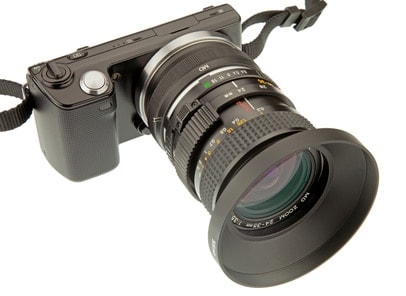What do you get when you cross-pollinate a compact camera with a DSLR? A mirrorless camera!

DSLRs use a mirror to bend the light from the lens into a viewfinder so you see what the camera sees. When you fire off the shutter, the mirror flips up, the shutter in front of the sensor opens and the sensor captures the image. With a mirrorless camera, the light passes from the lens directly onto the image sensor, similar to the way point-and-shoot cameras and smartphones work. There is an LCD screen on the back to preview the image. Most mirrorless cameras don’t have a viewfinder. Because mirrorless cameras have no mirror and use a different shutter mechanism, they have a simpler construction allowing them to be smaller and more compact.
With the mirror out of the way, mirrorless cameras can offer a larger sensor – and a larger sensor means better image quality. (Large sensors have more to do with image quality than megapixels.) Most compact cameras have a sensor that is decidedly smaller. Without a mirror in the camera, it eliminates the possibility of camera shake (camera shake is when the mirror flips up and creates some movement or vibration, potentially causing your photos to lose sharpness).
However, mirrorless cameras do have some disadvantages. Mirrorless cameras are slow to autofocus and have problems tracking moving objects. This becomes painfully evident in sports photography or even trying to keep small, active children in focus. The inability of the mirrorless camera to lock onto a moving target means that you could potentially miss the shot altogether. Mirrorless cameras are less able to focus in low light situations. Another tradeoff is in battery life. A small camera means a smaller battery, and a smaller battery means the battery gets drained faster. Mirrorless cameras also lack a lot of the features of a DSLR, so if you love to tweak your camera settings you will be out of luck. And keep in mind that because mirrorless cameras are relatively new, there are fewer lenses and third-party accessories currently available. (We all know that half the fun of photography is the gear!)
While mirrorless cameras aren’t exactly pocket-sized, their size, price and variety of options make them an attractive alternative to the DSLR.

I will be thankful if u advertising me to how to get best image with nikon d 610